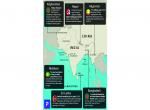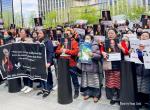The consequences or outcomes of any deliberate aggression can never be foreseen in exactitude, many will be unintended and many a time unanticipated and with unexpected drawbacks. Indeed, many outcomes will have unexpected benefits, that can fall into the enlarged notion of Karma! Though the aggressor may hate to admit, the outcome can also have perverse results, contrary to what was expected. It’s been a year since the deliberate, premeditated aggression by PLA as seen in May 2021 in Eastern Ladakh (EL). It is time hence, to deliberate and attempt prognostication – latter of course in a vacuum of authentic information and plethora of focussed propaganda and fakery!
Indeed, justification of Chinese aggression, which it most certainly was, has been debated comprehensively, and repetition can only be based on aggregation. Two mechanised/ motorised divisions surreptitiously side-stepped from training areas to Aksai Chin, followed by multi sub-sectoral aggression in EL, both first of their kind events. Premeditation by PLA was, hence, obvious. Evidently China appreciated that in concentric circles of hierarchy of geo-political achievements, it had crossed the threshold of aggregate size of economy, strong politico-economic hold on large comity of nations, reasonably modernised military and widespread spirit of internal nationalism. Time then was ripe to flex geo-political muscle, pandemic notwithstanding. This apparent fundamental transition in geo-political ambitions of President Xi and the Central Communist Party (CCP) had manifested in multiple regional arenas, including EL.
Indian armed forces, though caught on the wrong foot initially, showed resolute action at Galwan on 15 June 2020, and exhibited the logistical strength to sustain the inducted troops over the winter. The game-changer riposte by the Indian army units at the heights astride Spanggur Gap and the Fingers area North of Pangong Tso (PTSO) had proven many a point. The posturing along the LAC and preparations of Indian Armed Forces provided immense confidence nationally. Despite the Agreement signed in Moscow by the External Affairs Minister of India and Minister of Foreign Affairs of China on 10 September 2020, eleven rounds of extensive Military Talks at Chushul/ Moldo and the sub-sectoral disengagement in EL, there is yet total trust deficit, at least along the LAC. The Agreements and the CBMs of the past stand frozen.
The current state of the LAC had highlighted certain outcomes that have long term ramifications. These are examined in five broad strands. First, is apparent creation of buffer between PLA and the Indian Army units in EL. Historically while proposing the 1959 Line, PM Zhou en Lai had accepted that “…two countries have never formally delimited this boundary and that there is a divergence of views between the two countries regarding the boundary.” He had then recommended that ‘…to ensure the tranquillity…. withdrawing 20 kilometers from the so-called McMahon line in the east, and from the line up to which each side exercises actual control in the west…” At that juncture in history and six decades that followed, concept of ‘buffer’ between forces at the LAC had not been acceptable to India, even in the six Agreements that were signed.
A major unintended consequence has been creation of patrolling moratoriums in disputed areas, which, willy-nilly implies creation of buffer zones without challenge to proclaimed claim lines. It commenced with Galwan, post 15 June 2020 incident, when both forces withdrew one to two km either side of PP14. Consequently, post Tenth Round of Talks, a buffer was created along Fingers 4 and 8 of PTSO North Bank. The disengagement process South of PTSO and the Kailash Range has also created a buffer zone, with a verification system. Though not formally decided, both forces on Raki Nalla, at Depsang Plateau and Gogra, near Hot Springs, maintain distance. The buffer zones along the LAC have not been formalised as a method to maintain peace and avoid clashes in future. Yet, it is apparent that China will proceed further on disengagement, whenever, with buffer zones as a consequential foundation, could even be in middle and eastern sectors, attempting to create a Belt or Zone over a Line.
Second, is the quick-time change in quantum of force and infrastructural development that has taken place in last one year. PLA undertook mobilisation from training areas to area of operations, exhibited the art of creating defences and sangars, as seen on the ridge line of Finger 5. Only after 1979 war with Vietnam that PLA, in that rarest of the rare happenstance in 2020, moved tanks to very close adversarial proximity, loaded artillery guns and had the ubiquitous infantry with fingers on the triggers, in an intensely tense environment. China has enhanced habitat in Rudog and Ngari (Ali) on G219 Western highway for retaining the accretional forces in the area. A consequence of 2020, creation of infrastructure and habitat, and permanent or temporary relocation of forces in relative the proximity to LAC, indicates future posturing of PLA, and mandates adequacy of response.
Third, is the aftermath of Galwan clash. It was only on 19 February 2021, seven months after the incident that China state-owned People’s Liberation Army Daily intimated that ‘four’ (taken with more than a pinch of salt) Chinese frontier officers and soldiers stationed in Karakoram Mountains died in Galwan clash where 20 Indian soldiers were also killed. After 1962 India-China War (which China called “Counterattack in Self Defense on China-India Border,”) PLA’s official casualties of 722 PLA soldiers killed and around 1,400 wounded, were intimated in internal history document 32 years later, in 1994. There is an obvious fear of adverse public sentiment, and to retain halo of invincibility of PLA and CCP! Obviously, in an end state of conflict, if China has to admit to large number of casualties (colloquially body bags), there may be singular loss of face, internally, with its unforeseen consequences. That perplexion could well be indicative of manner in challenging force asymmetry.
Fourth, is status of the LAC which Chinese Ministry of Foreign Affairs spokesperson Wang Wengbin’s statement on 27 Sep 2020 indicated “…China-India border LAC is obvious, that is the LAC on November 7, 1959. China announced it in the 1950s, and the international community, including India, is also clear about it”. To that Indian MEA spokesperson responded “…India has never accepted the so-called unilaterally defined 1959 LAC. This position has been consistent and well known, including the Chinese.” The concept of LAC is gravelly flawed, and seeking ‘peace and tranquillity’ within its ambit is problematic. President Xi had stated in closing meeting of the First Session of the 13th NPC in 2018 that "The Chinese people share a common belief that it is never allowed and it is absolutely impossible to separate any inch of our great country's territory from China." India will protect her territorial integrity at all costs and that can be taken as a BROAD RED LINE. It is also strongly evident after the 29/30th August operation of Indian Army that any loss of (even claimed) territory hurts the PLA / CCP tremendously. There was massive over-reaction by sending forces, tanks and infantry, climbing up from Spanguur Tso to Rezangla-RechinLa, to hand-shaking distance of the deployed Indian Army units. But for the fire-control exhibited, in any other circumstance this was hara-kiri! Apparently, for PLA/CCP, any infringement of their ‘1959 Line’ is totally unacceptable, and which indicates significant vulnerability in operational philosophy. Offense hence is the best form of defence, even in super high altitude, which can force disproportionate and hasty response, outside realms of military prudence.
Apparent also therefore, as a consequence of aggression by PLA, response by Indian Armed Forces and protracted talks and current hiatus, is that resolution of LAC and long term peace does not rest in Military Talks at Chushul/Moldo, but through larger politico-diplomatic initiatives. In the interim, situation on LAC should remain frozen in tense peace, with forces stretched to their limits.
Fifth and importantly, is the debate on likelihood of escalation to conventional war. It has been contemplated that volatile situation in EL was ripe for inadvertent or accidental escalation – end-state of which could have been unpredictable. Could PLA have used escalation-opportunity to initiate war and larger conflagration? In forecasting offensive operations that could at best have been undertaken by the quantum of force that PLA brought into EL, it becomes apparent that the larger aim was more coercion and intimidation than significant territorial expansionism. The medieval weapons at Galwan and at Finger 4 (PTSO) showed another story. EL was not a type of ‘gun boat’ diplomacy, and military deployments do not indicate war is on the horizon. PLA is an instrument of the CCP, with strong political commissar system and the President as the Chairman of the apex decision-making CMC. Commencement of wars obviously is not delegated to field, even Theatre Commanders. The consequence events of the deaths of soldiers at Galwan, the Indian Army’s occupation South of PTSO on 29/30 August 2020 and many an unreported event of belligerence, is that war is not a given. Wars hence cannot be deemed to start with any form of escalatory incident on ground; it requires the call to be taken at CMC. That does not deny coercive use of controlled force. Similar parallels can be drawn on Indian side too. War, between India and China, if ever to take place, will be a deliberate, well planned and executed decision, and not an impulsive conflagration based on sub-tactical inadvertence or accident.
Indeed, a very significant consequence that the belligerence of China was the much advanced QUAD summit meeting, and exercises in the high seas. Series of overreactions in China did indicate anxieties! Indian forces response to the aggression was strong and measured, and impetus was provided to sorting the real-time ISR grid. Importance of reorganising manageable areas of responsibilities to tactical formations, retention of acclimatised reserves and much delayed rebalancing of forces from the Western sector were executed. Senior military hierarchy has also indicated much widened perspectives in preparations of modern war, in all its manifestations.
There would have been large number of tactical lessons that troops and commanders on ground would have picked up. There is need to collate these and plan to take advantage of the knowledge-base.
(The paper is the author’s individual scholastic articulation. The author certifies that the article/paper is original in content, unpublished and it has not been submitted for publication/web upload elsewhere, and that the facts and figures quoted are duly referenced, as needed, and are believed to be correct). (The paper does not necessarily represent the organisational stance... More >>
Image Source: https://akm-img-a-in.tosshub.com/indiatoday/images/story/202008/Tso_0.jpeg?L_vlZ6.dLeOC_2rN9.sLLJhGp5if4644&size=770:433











Post new comment